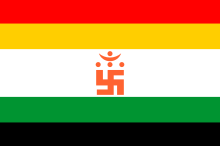Jain symbols

| Part of a series on |
| Jainism |
|---|
 |
|
Jain prayers |
|
Ethics |
|
Major figures |
|
Major sects |
|
Festivals |
|
Pilgrimages |
|
|
Jain symbols are symbols based on the Jain philosophy.
Swastika
Swastika is an important Jain symbol. The four arms of the swastika symbolize the four states of existence as per Jainism:[1][2]
- Heavenly beings (devas)
- Human beings
- Hellish being
- Tiryancha (subhuman like flora or fauna)
It represents the perpetual nature of the universe in the material world, where a creature is destined to one of those states based on their karma. In contrast to this circle of rebirth and delusion is the concept of a straight path, constituted by correct faith, understanding and conduct, and visually symbolized by the three dots above the running cross of swastika, which leads the individual out of the transient imperfect world to a permanent perfect state of enlightenment and perfection. This perfect state of liberation is symbolized by the crescent and dot at the top of the svastika.[1]
It also represents the four columns of the Jain Sangha: sadhus, sadhvis, sravakas and shravikas - monks, nuns, female and male laymen. It also represents the four characteristics of the soul: infinite knowledge, infinite perception, infinite happiness, and infinite energy.
Symbol of Ahimsa

The hand with a wheel on the palm symbolizes Ahimsa in Jainism. The word in the middle is "ahiṃsā" (non-injury). The wheel represents the dharmachakra, which stands for the resolve to halt the saṃsāra through the relentless pursuit of Ahimsa.
Jain emblem
In 1974, on the auspicious 2500th anniversary of the nirvana of the last Jain Tirthankara, Mahavira, the Jain community at large collectively chose one image as an emblem to be the main identifying symbol for Jainism. Since then, this emblem is used in almost all of Jain magazines, on wedding cards, on Jain festival cards and in magazines with links to events related to Jain society.
Fundamental concepts
The Jain emblem is composed of many fundamental concepts and symbols. The outline of the image represents the universe as described in Jain Agamas. It consists of three Loks (realms). The upper portion indicates heaven, the middle portion indicates the material world and the lower portion indicates hell.
The semi-circular topmost portion symbolizes siddhashila, which is a zone beyond the three realms. All of the siddhas or liberated bodiless souls reside on this forever, liberated from the cycle of life and death. The three dots on the top under the semi-circle symbolize the Ratnatraya – right belief, right knowledge, and right conduct. Every creature in this world can become free from the cycle of life and death. This gives the message that it is necessary to have the Ratnatraya in order to attain moksha.
In the top portion, the swastika symbol is present.
The symbol of hand in the lower portion shows fearlessness and symbolizes the feeling of ahimsa towards all the creatures in this world. The circle in the middle of the hand symbolizes saṃsāra and the 24 spokes represent the preachings from the 24 Tirthankaras, which can be used to liberate a soul from the cycle of reincarnation.
The meaning of the mantra at the bottom, Parasparopagraho Jivanam, is "All life is bound together by mutual support and interdependence."
In short, the Jain emblem represents many important concepts to show the path to enlightenment by following the basic principles of ahimsa, the Ratnatraya and Parasparopagraho Jivanam.
Usage
It is important that an emblem or symbol is used consistently in the same format to preserve its value and the meaning. There are many variations of the symbol in use currently. However, they do not show all the fundamental concepts embedded in the current emblem. For example, JAINA in North America uses a modified version of the standard Jain symbol. It replaces the swastika with Om because the swastika is associated with Nazi Germany there.[3]
Jain flag

The Jain flag depicts the panch parmeshtis (five great virtuous entities):
- Arihantas: enlightened beings
- Siddhas: liberated souls
- Acharyas: spiritual leaders
- Upadhyays: spiritual teachers
- Sadhus and Sadhvis: spiritual practitioners
Other Jain symbols
The Om symbol is used in ancient Jain scriptures to represent the five lines of the Navakar mantra,[4] which is the most important part of the daily prayer in the Jain religion. The Navakar mantra honors the panch parmeshtis.
Photo gallery
_-_Oct_2010.jpg) Symbol usage at the Udayagiri and Khandagiri Caves, Odisha, India
Symbol usage at the Udayagiri and Khandagiri Caves, Odisha, India
See also
Notes
- 1 2 Cort 2001, p. 17.
- ↑ Jansma & Jain 2006, p. 123.
- ↑ "Jain Symbols". p. 29. Retrieved 2012-03-16.
- ↑ "Namokar Mantra". Digambarjainonline.com. Retrieved 2014-06-04.
References
- Jansma, Rudi; Jain, Sneh Rani (2006), Introduction to Jainism, Jaipur: Prakrit Bharti Academy, ISBN 81-89698-09-5
- Cort, John E. (2001), Jains in the World : Religious Values and Ideology in India, Oxford University Press, ISBN 0-19-513234-3